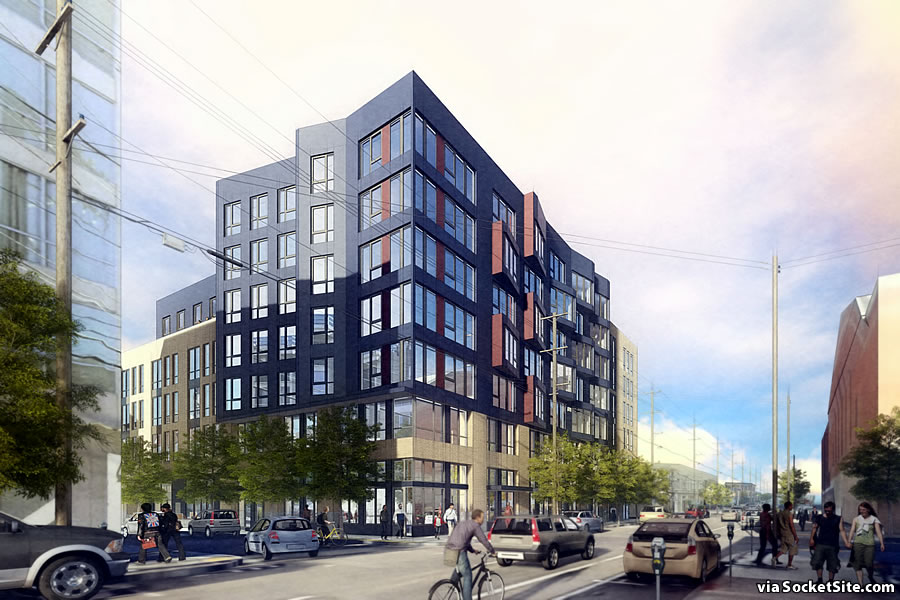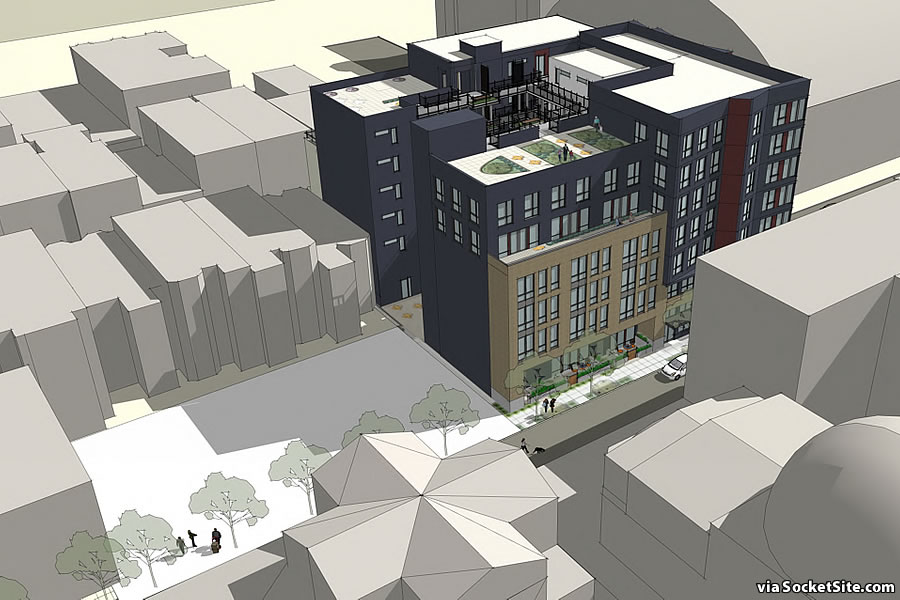Fully-entitled for the development of a 7-story, 78-foot tall building, with 60 high-end condos averaging over 1,000 square feet apiece and 5,658 square feet of ground floor retail space back in 2019, a permit to build upon the Mission District parking lot parcel at 344 14th Street, across from the Armory, was approved and issued last year but the ground has yet to be broken.
At the same time, a request to extend the operation of the corner parking lot was just accepted by the City and an offering memorandum for the project site and adjacent surface parking lot parcel for 24 cars at 1463 Stevenson Street are now making the rounds rather than being prepared to break ground and the pipeline of approved developments which aren’t actively being built continues to grow. We’ll keep you posted and plugged-in.


High-end condos will attract a certain demographic. Developments like this one do nothing to ease the housing burden for the less affluent. I’m not being critical, just making a statement.
Developments like this one won’t even add to the supply of housing targeted at the more affluent, if the sites for the proposed housing get traded around like Magic: the Gathering cards and don’t actually result in any new housing.
You’re right: we need more people willing – and able! – to build at the +/- $500/s.f. it costs, and yet somehow sell for the $250/s.f. the “less affluent” can pay.
Speaking of which – sort of – here’s a bit of cheerless news on the building front. Yeah, sure the whole thing was likely overhyped, but nonethless I see nothing good about this.
Which is why “Another Stalled Development [is now] Trying the “Auction” Route,” as we first reported and foreshadowed over a month ago…
See also Katerra going bankrupt a couple of years back after burning through $2 billion in funding from Softbank alone inside of four years. But we shouldn’t be surprised by this. According to the U.S. Bureau of Labor Statistics (scroll down to chart 4.), the 10 year survival rate for construction companies in general ranks among the lowest across all surveyed industries.
I seriously doubt that there is going to be any silver bullet to remedy growing construction costs, and that includes off-site construction and modular housing startups. If we want more affordable housing to be built, we’re going to have to do what works in other countries: get the government to build more housing, and stop relying solely on fickle capitalists who only want to build housing for the top tier of the market.
” If we want more affordable housing to be built, we’re going to have to do what works in other countries: ”
Around 80% of the generally affluent population of the notoriousl Marxist hellhole(/s) that is Singapore live in public housing. Public housing works just fine – even in neo-liberal capitalist economies – when the ruling classes allow it to work. But the ruling classes in the good ol’ USA get too much pleasure from stepping on American workers’ necks with their iron boots to ever let anything like that happen here.
The distinct difference being – governments in Singapore, Vienna (another city owning vast amounts of RE) actually knowing to care for their housing stock. San Francisco? Not so much, it would take a fundamental change in culture. Not in the offing, considering how everybody’s got their heads up their behinds, busy trying to siphon off “what’s theirs”.
How long have you actually lived in SF? Must n’t be that long as you dont seem to have been around when pretty much all public housing in SF had to be handed over to private management back in the 1990’s due to total and complete dysfunction of the San Francisco Housing Authority.
The SFHA was already in a death spiral when Moscone made Jim Jones (yes, that Jim Jones – Mr Jonestown) head of the Housing Authority in 1976. Which Jones promptly looted. During the 1980’s and 1990’s it was just one scandal after another and eventfully actual building management had to be handed over to private companies because the SFHA was so corrupt, incompetent and had functionally collapsed as an organization.
A far cry from the 1930’s when it was first set up. Public housing in SF was not that terrible for the first few decades as long as there was a Republic mayor in City hall and the Board of Supes had not one single “activist” on it. But by the time Shelly and Alioto came along the usual rot had set in with SF City government organizations but it was them and the people they appointed that put public housing in SF into a rapid death spiral. So that within a decade, by the late 1970’s, it had pretty much collapsed. And HUD did not help either.
Public housing in SF only started to improve decades later in the mid 1990’s when building management was taken away for the SFHA (due to Federal lawsuits) and all but one of the projects was “refurbished”, rebuild with fewer housing units so that all the criminal trouble makers could be legally evicted. So the 20K or so residents of public housing who remained now had nice safe places to live managed by (mostly) competent private companies. And once nasty crime-ridden neighborhoods were now safe for everyone. No longer left hand lane driving only on Army St at night. etc.
Want Singapore style public housing well you can only get it with Singapore style city government. And Singapore style law enforcement. Ever been to Singapore? I strongly suspect you would hate it.
The public housing in SF tfourier’s talking about was intended to house the poor. The rest of us are talking about housing for the middle and working classes that make S.F. what it is, and the fact that the free market has consistently failed to deliver it over the past thirty years.
And there are other land-constrained cities, even in Asia, that have large portions of housing built by the government and inhabited by people of all social classes without Singapore-style authoritarian regime in charge of that government. The example I am most familiar with is Hong Kong prior to the handover from the United Kingdom to the People’s Republic of China. Even today, over 46 percent of Hong Kong residents still live in public permanent housing.
Because the government will build it cheaper? If only life worked out like a night school philosophy course…
If we want more affordable housing to be built,
So remove the pretense that’s what we really want, and the “problem” is solved ?
Depends on the corporeal composition of “we,” eh?
Agree. Why is everything “high end” even in “low end” locations like this. I would never spend the kind of money associated with “high end” to live in a location like that. I wonder what percentage of sales of these types of properties go to investors who never set foot on the property and then turn into absentee landlords who don’t care if the units stay vacant…exacerbating our housing shortage.
No, you can be critical.
I know this is never a popular thing to say, but this area is always a little sketchy. Yeah, it’s close to Valencia, but it’s also close to Mission. If I was in the market for high end condos, this would not be my preferred area. 15th/Mission is one of the worst areas in the city.
IMO that location doesn’t support high end luxury units. Better suited for workforce housing, whatever that means.
“workforce” is a shorthand euphemism for “highly-exploitable people doing underpaid yet essential labor,” so in San Francisco, “workforce housing” means redtagged apartments with ten or more adult sleepers per room, in shifts.
Sure…but look at how many letters we save.
Imagine the carbon footprint of all those extra letters …wafting off into space…forever
it’s ok; i’m trying to offset my crypto/ai/forum-trolling carbon footprint bloat by using fewer capital letters. now, if i can just eliminate the semi-colons from my rants, it’ll be like shutting down the grid in a mid-size industrial economy!
Tell us how you really feel.
Before the rebuild of the VG (Valencia Gardens) in the 1990’s the blocks either side of Valencia street north of 16’th were very sketchy during the day and outright dangerous at night. Parking anywhere north of 16’th until you got over to Dolores was a very bad idea. East of Valencia, forget it. Now 30 years later the next generation of the small minority in the VG who cause most of the problems in those blocks is overdue to be cleared out again and sent to the East Bay (like last time) but due to a recent AB unlikely to happen anytime soon.
Are you referring to the criminal record overlook for public housing bill? How is that even supposed to work? How can you manage a property without information like that? It might help you avoid a few false positives at the cost of a bunch of true positives – unless that’s somehow accounted for? I highly doubt it.
This and most other proposed buildings seem to consist of mostly 1br apartments. I wonder if that will start to change. More 2 or 3 bedroom units that are suitable for couples or roommates would be more affordable and maybe more indemand. I assume that from the developer’s standpoint, more 1br units is theoretically desirable, but not if nobody wants to buy/rent them.
Actually, this development was entitled to yield 4 junior one-bedrooms, 17 one-bedrooms and 39 twos (i.e., mostly twos), as linked (and we originally reported) above.
A “junior” one bedroom being a zero-bedroom, but with a big Les Nessman style line on the floor where the wall should go ??
Oh lookee, it appears that’s exactly what it means
(the count of which now totals 60 with a mix of 4 studios, 17 one bedrooms and 39 twos)